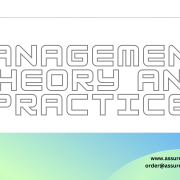Introduction
The current paper discusses the nature of lean practices right from its beginning in the automotive industry located in Japan, which describes its translation and its adoption in the West. It aims to give a literature review that is about the principles of lean by making it a concept and applying it in the public sector along with its implementation by mainly emphasizing health care (Camuffo & Gerli, 2014). As per Fullerton, Kennedy & Widener. The main objective of this literature is to give a clear understanding of the nature of lean before it is taken into consideration of its applicability in the organizations of the public sector specifically in health care to shape and guide the review (Fullerton, Kennedy & Widener, 2014).
According to Galindo & Batta, the review is organized as follows first the important contributions that are made by lean towards the operations management field have been outlined and in continuation, the differences and similarities that are found between the lean and the approaches made by others for their improvement have been discussed (Galindo & Batta, 2013).
In the second section, the development of the principles of lean concerning the Toyota Motor Company in Japan during the year 1950’s the viewpoint of history is defined. The paper starts with the introduction of the overview of the methodology of lean and how was it introduced first and its interpretation in the Western world (Harris & Cassidy, 2014). In this section, the influence of this lean principle on the production system, and development of Toyota in Japan is considered. In the following section, the development made through evolutions in the history of the practice of manufacturing is concluded by representing the lean nature.
I. The nature of Lean practices.
The perspective of operations and process management
The operations management concept is defined as the way used by the organization for the production of goods and services. As per Khanna, the concept of operations management is found to be expanded recently in the form of operations and process management to indicate the subject extension to the entire organization, and also the processes that are of non-operation functions are included such as the sales made after purchasing and the finance (Khanna, 2015).
Piercy & Rich said that for all the sectors the operations and the process management are found to be the main part, which includes the public and private sector, the service sector, the manufacturing unit, and the sector of volunteering as all of these are involved in the production of goods and or services (Piercy & Rich, 2015). In this chain, all of these organizations can be included as a concept under the transformation process in which the operations and the process will be taking the set of resources that are used later in transforming them into outputs or goods and services to satisfy the needs of the customer.
The basic principle of operation management can be briefed out as the organization should make sure that the input resources should be sufficient to meet demand levels of the present day, tomorrow, and in the future and eventually, the areas that are needed to be improved in terms of service are to be identified (Resta et al., 2015).
The perspective of the process
There are various processes by which the organization is made, which are representing the small operations. It is the process that is linked to the set of activities that are having the particular organization for its space and work, with all the start and end aspects and the inputs and outputs clearly defined. The main processes might get connected or interlock with the further sub-processes or the starting or the ending of the later process. As per Smith, when the perspective of the process is taken, it indicated that the customer’s view is being adopted. It is explained by McNulty about the process perspective as it is the value creation that is more concerned with it than just the value creation control process (Smith, 2017).
The contributions made by Lean have been taken as the most important aspects of operations management by Slack et al for more than 50 years. Slack and Lewis have summarized the contributions made by Lean to operations management where the authors state that before the development made by Lean operations management has been the loose gathering of ideas relatively from the era of scientific management is clearly explained by them.
II. The main ways in which Lean is considered to be “a radical departure from traditional operations practice”
The achievements made by Lean are it has given a better understanding of the fields such as how the inventory of the products, the throughput time, how it adds value to it, elimination of waste, proper utilization of resources, and flexibility are related to one another.
From Mass production to Lean production
As per Sekar, for mass production and batch processing, the Lean method is considered to be an alternative method. Mass production is involved in the production of large scale which is more than the demand of the customer, to keep the costs low for the unit and to result in higher productivity (Sekar, 2014).
The main point of lean is that the batch size should be minimized to the possible extent. To keep the pace of production with demand, Lean proposed the one-piece flow production continuously, hence both objectives can be achieved such as low unit costs and the quality of higher levels. Hence the Lean principles are found to counter the principles of other traditional manufacturing and are known to echo the craft manufacturing principles in which the production will be processed only when the customer has ordered it.
Leading to the elimination of inventory from push to pull
When the volume production is higher in the batch production then it leads to mass production. If the varieties in the process are predictable reasonably and known by us then batch production is frequently used. As Zhang, Gregory & Neely, in batching, the work progress towards the next step is only allowed when the processing of the entire batch has been carried out, hence a significant amount of waiting will occur in the system of batch processing resulting in the poor cycle and the low throughput times (Zhang, Gregory & Neely, 2016). The impact of batching in the service operation has been described by the Swank as follows: At any certain point of time, the batch in a traditional system will be waiting for its turn to get processed or it can be termed as the excess inventory is costly.
Waste elimination
The industrial engineers Shigeo Shingo and Taichi Ohno have strongly supported the elimination of all waste. As per Harris & Cassidy, to be specific Shingo is very much famous for representing waste defines waste as any kind of activity that has no contributions to the operations like waiting, accumulation of the parts that are semi-processed, loading again, passing of the resources from one to another to which the author added without any improvements at work entirely it cannot be eliminated (Harris & Cassidy, 2014). Hence it is necessary that understanding the process should be confirmed to remove the waste which has been combined with the recognition as it is a process that is continuous. Further, the waste is defined by Shingo as the process of manufacturing there are seven wastes identified and are to be eliminated such as:
- Overproduction than what is required by the consumer
- Delay would hinder the product flow to the customer
- Transportation as it does not add any value
- If the processing is more than the requirement
- Expenditure but no income
- Indications of damage
- If defects are identified it costs extra or delays
The various tools of Lean
As per Galindo & Batta, there are various numbers of tools which are associated with Lean. Whereas most of the commentators say that Lean is not supposed to be seen as a tool set as it will not help identify the wastes and cannot be evaluated on its elimination when it is correctly used and strong foundations are built which will be consisting of the leadership skills, the strategic alignment, learning and training, and engaging the staff (Galindo & Batta, 2013). It is proposed by Womack and Jones, Bicheno that linking of tools of Lean with his five principles it is known to differentiate between the tools which will be identifying the value, the tools which are prepared for flow, tools that are used for mapping and analysis, tools which are used for making sure of quality and tools that are involved in improving continuously.
III. Lean has “become orthodox”: A new management orthodox
The fields of operations management have been continuously influenced by Lean since the early 1990s. As per Fullerton, Kennedy & Widener, the declaration has been given by Taylor and Taylor that our form of understanding the lean in the form of a 39 Production Management of Japan is still under development irrespective of the investigation that has been done for two decades. Contrary to it, some of them suggest that the practices and the ideas of Lean have been considered to be radical and are now known to become Orthodox (Fullerton, Kennedy & Widener, 2014).
Apart from manufacturing the ideas and the practices of Lean are still under consideration because they are radical and new in the service industry in which Lean is reflected to be newly fashionable. As per Galindo & Batta, the opinion of Lean as an Orthodox in manufacturing can be considered as a competition given it has been noticed that less than 10 percent of the implementations of Lean in the organizations of the UK are believed to be successful (Galindo & Batta, 2013). The problem has been emphasized by Liker who suggested that though the concept has gained acceptance its implementation in the practices is not happening in reality.
Exploring the context of lean and challenges
Even though the investigation has been carried out for two decades, Taylor and Taylor have described that the manufacturing practices of Japan in processing the richness in distinction and complexity will always appear to be beyond our understanding. As per Fullerton, Kennedy & Widener, various authors have tried and wanted to identify the factors of success and the barriers to lean implementation. For instance, it is stated by Alukal that in the support of long-term management the fundamental role is found to echo the literature of change management widely (Fullerton, Kennedy & Widener, 2014). It has been argued by Corbet that it is important to understand the success factor in terms of the increasing orthodoxy that has been perceived about the Lean techniques which means that the Lean implementation will be becoming the factor to distinguish between the organizations. On the contrary to it, from a practical viewpoint, Taylor and Taylor attempted to crystallize the Lean top ten success factor at the local level. The Lean factors are explained in detail in the form of the Toyota Production System.
A voyage of industrial tourism – from Toyota production system to Lean
For representing the manufacturing method the term Lean is noticed in the Toyota Motor Corporation in Japan, which is also familiar with the name Toyota Production system. John Krafcik used the term Lean in the year 1988 in describing the observations that have been made by a team of researchers which is considered to be a part of the International Motor Vehicle Program. As per Camuffo & Gerli, it has been established in the US for investigating the reasons why the outperformance of Japan is seen in the West in terms of quality. The interpretations and the effects of the methods of Toyota about the superior performance have been gained and were recounted by the researchers (Camuffo & Gerli, 2014).
From craft to science- manufacturing
The fundamental synopsis has been offered by some authors in terms of manufacturing, transforming from the production of crafts to the development of mass manufacturing, and the later thoughts of lean. The evolution of the early methods of manufacturing has been detailed by some other authors where Adam Smith’s early experimentation in breaking the work crafts into tasks that can be repeated simply to promote productivity in huge amounts as a precursor for the TPS has been cited. As per Resta et al, at present, the essential components of the manufacturing process have now become the Invention of 44 interchangeable parts of Eli Whitney’s and the Whitworth standards of development. Earlier to Joseph Whitworth, the standard threads were developed for facilitating bolt interchangeability, the craftsmen were supposed to create the new bolts and also the threads for every independent production unit which was found to be a very costly and tedious process (Resta et al., 2015).
The labor has been divided into smaller tasks which can be repeated by Smith and the standards of Whitworth have been incorporated into the production system of Ford in the 1920s for creating the manufacturing system which was indicated as a singularity for the output production worldwide. From the overview of manufacturing history, it has been demonstrated that the methods of production are just not the single point of inventions, it is the accumulation of concepts and ideas over time. Further, the development of the Lean principles has been influenced by the changes that have taken place in the context of operations. For instance, the mass production system of Ford was found to be extremely successful until the time market did not need the number of varieties that the production system was giving since it was built under stable demand (Khanna, 2015). The following table illustrates how manufacturing has evolved and what kind of influence it had on the early craftsmanship till the manufacturing of lean.

Figure 1: Historical Timeline of Lean Manufacturing
Source: (Galindo & Batta, 2013)
Training in the quality
It has been described by Kunonga et al the combination of the usage of limited resources, workforce labor who are unskilled, and poor management, which has eventually led to the production of products that are of poor quality in Japan. Because of this, the major drive was taken over by organizing the inspection body for national quality checking for improving the quality and to provide training to the engineers and managers of Japan on the techniques of quality improvement (Harris & Cassidy, 2014). For orienting the audience of Japan towards the processing point of view they used production as the system. The following diagram has the purpose of viewing the operation carried out on a system level instead of focusing on the independent functions (Resta et al., 2015).

‘Production viewed as a system’
Figure 2: Source (Harris & Cassidy, 2014)
Conclusion
In the first section, the context of Lean toward operations management is found to be gaining the fundamental challenges of changing the mindsets from the traditional functioning point of view towards the operations and the process market with the implementation of the Lean principles. It is evident from the literature that Lean implementation is widespread in the healthcare industry. The transition from the traditional approach to the Lean approach is emphasized and it eventually led to success. It is suggested by Taylor and Taylor and Schonberger it can be the reflection of the least understanding of the TPS in the form of the holistic approach. Hence the approach made by Lean and his concepts should be understood carefully (Schonberger 2011). In the other section, the developmental process of Lean with the origin of the Japanese Toyota production system has been discussed where the quality and training are given importance which is the irony.
References
Camuffo, A. and Gerli, F., 2014, January. Lean production systems and financial performance: a configurational fuzzy-set approach. In Academy of Management Proceedings (Vol. 2014, No. 1, p. 17094). Academy of Management.
Fullerton, R.R., Kennedy, F.A. and Widener, S.K., 2014. Lean manufacturing and firm performance: The incremental contribution of lean management accounting practices. Journal of Operations Management, 32(7), pp.414-428.
Galindo, G. and Batta, R., 2013. Review of recent developments in OR/MS research in disaster operations management. European Journal of Operational Research, 230(2), pp.201-211.
Harris, D. and Cassidy, J., 2014. The Adoption of Lean Operations and Lean Accounting on the Profitability and Cash Flows of Publicly Traded Companies. Advances in Management Accounting (Advances in Management Accounting, Volume 22) Emerald Group Publishing Limited, 22, pp.71-96.
Khanna, R.B., 2015. Production and operations management. PHI Learning Pvt. Ltd.
Piercy, N. and Rich, N., 2015. The relationship between lean operations and sustainable operations. International Journal of Operations & Production Management, 35(2), pp.282-315.
Resta, B., Powell, D., Gaiardelli, P. and Dotti, S., 2015. Towards a framework for lean operations in product-oriented product service systems. CIRP Journal of Manufacturing Science and Technology, 9, pp.12-22.
Schonberger, R.J., 2011. ASP, The Art and Science of Practice: Taking the Measure of Lean: Efficiency and Effectiveness. Interfaces, 41(2), pp.182-193.
Sekar, K.V. ed., 2014. Manufacturing engineering and technology. Prentice Hall.
Zhang, Y., Gregory, M. and Neely, A., 2016. Operations Challenges for Professional Engineering Services.











